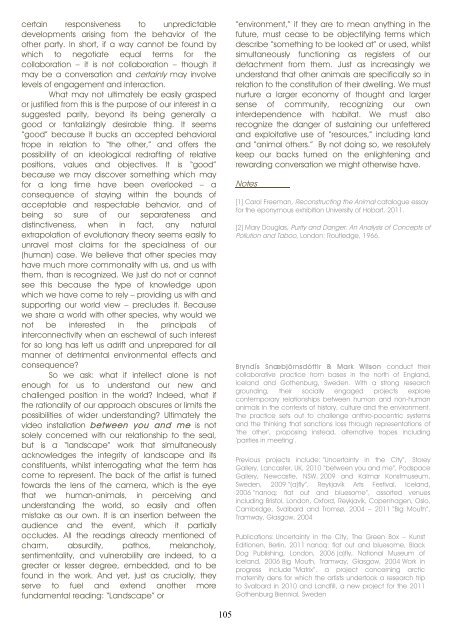Animal Influence I - Antennae The Journal of Nature in Visual Culture
Animal Influence I - Antennae The Journal of Nature in Visual Culture
Animal Influence I - Antennae The Journal of Nature in Visual Culture
Create successful ePaper yourself
Turn your PDF publications into a flip-book with our unique Google optimized e-Paper software.
certa<strong>in</strong> responsiveness to unpredictable<br />
developments aris<strong>in</strong>g from the behavior <strong>of</strong> the<br />
other party. In short, if a way cannot be found by<br />
which to negotiate equal terms for the<br />
collaboration – it is not collaboration – though it<br />
may be a conversation and certa<strong>in</strong>ly may <strong>in</strong>volve<br />
levels <strong>of</strong> engagement and <strong>in</strong>teraction.<br />
What may not ultimately be easily grasped<br />
or justified from this is the purpose <strong>of</strong> our <strong>in</strong>terest <strong>in</strong> a<br />
suggested parity, beyond its be<strong>in</strong>g generally a<br />
good or tantaliz<strong>in</strong>gly desirable th<strong>in</strong>g. It seems<br />
“good” because it bucks an accepted behavioral<br />
trope <strong>in</strong> relation to “the other,” and <strong>of</strong>fers the<br />
possibility <strong>of</strong> an ideological redraft<strong>in</strong>g <strong>of</strong> relative<br />
positions, values and objectives. It is “good”<br />
because we may discover someth<strong>in</strong>g which may<br />
for a long time have been overlooked – a<br />
consequence <strong>of</strong> stay<strong>in</strong>g with<strong>in</strong> the bounds <strong>of</strong><br />
acceptable and respectable behavior, and <strong>of</strong><br />
be<strong>in</strong>g so sure <strong>of</strong> our separateness and<br />
dist<strong>in</strong>ctiveness, when <strong>in</strong> fact, any natural<br />
extrapolation <strong>of</strong> evolutionary theory seems easily to<br />
unravel most claims for the specialness <strong>of</strong> our<br />
(human) case. We believe that other species may<br />
have much more commonality with us, and us with<br />
them, than is recognized. We just do not or cannot<br />
see this because the type <strong>of</strong> knowledge upon<br />
which we have come to rely – provid<strong>in</strong>g us with and<br />
support<strong>in</strong>g our world view – precludes it. Because<br />
we share a world with other species, why would we<br />
not be <strong>in</strong>terested <strong>in</strong> the pr<strong>in</strong>cipals <strong>of</strong><br />
<strong>in</strong>terconnectivity when an eschewal <strong>of</strong> such <strong>in</strong>terest<br />
for so long has left us adrift and unprepared for all<br />
manner <strong>of</strong> detrimental environmental effects and<br />
consequence?<br />
So we ask: what if <strong>in</strong>tellect alone is not<br />
enough for us to understand our new and<br />
challenged position <strong>in</strong> the world? Indeed, what if<br />
the rationality <strong>of</strong> our approach obscures or limits the<br />
possibilities <strong>of</strong> wider understand<strong>in</strong>g? Ultimately the<br />
video <strong>in</strong>stallation between you and me is not<br />
solely concerned with our relationship to the seal,<br />
but is a “landscape” work that simultaneously<br />
acknowledges the <strong>in</strong>tegrity <strong>of</strong> landscape and its<br />
constituents, whilst <strong>in</strong>terrogat<strong>in</strong>g what the term has<br />
come to represent. <strong>The</strong> back <strong>of</strong> the artist is turned<br />
towards the lens <strong>of</strong> the camera, which is the eye<br />
that we human-animals, <strong>in</strong> perceiv<strong>in</strong>g and<br />
understand<strong>in</strong>g the world, so easily and <strong>of</strong>ten<br />
mistake as our own. It is an <strong>in</strong>sertion between the<br />
audience and the event, which it partially<br />
occludes. All the read<strong>in</strong>gs already mentioned <strong>of</strong><br />
charm, absurdity, pathos, melancholy,<br />
sentimentality, and vulnerability are <strong>in</strong>deed, to a<br />
greater or lesser degree, embedded, and to be<br />
found <strong>in</strong> the work. And yet, just as crucially, they<br />
serve to fuel and extend another more<br />
fundamental read<strong>in</strong>g: “Landscape” or<br />
105<br />
“environment,” if they are to mean anyth<strong>in</strong>g <strong>in</strong> the<br />
future, must cease to be objectify<strong>in</strong>g terms which<br />
describe “someth<strong>in</strong>g to be looked at” or used, whilst<br />
simultaneously function<strong>in</strong>g as registers <strong>of</strong> our<br />
detachment from them. Just as <strong>in</strong>creas<strong>in</strong>gly we<br />
understand that other animals are specifically so <strong>in</strong><br />
relation to the constitution <strong>of</strong> their dwell<strong>in</strong>g. We must<br />
nurture a larger economy <strong>of</strong> thought and larger<br />
sense <strong>of</strong> community, recogniz<strong>in</strong>g our own<br />
<strong>in</strong>terdependence with habitat. We must also<br />
recognize the danger <strong>of</strong> susta<strong>in</strong><strong>in</strong>g our unfettered<br />
and exploitative use <strong>of</strong> “resources,” <strong>in</strong>clud<strong>in</strong>g land<br />
and “animal others.” By not do<strong>in</strong>g so, we resolutely<br />
keep our backs turned on the enlighten<strong>in</strong>g and<br />
reward<strong>in</strong>g conversation we might otherwise have.<br />
Notes<br />
[1] Carol Freeman, Reconstruct<strong>in</strong>g the <strong>Animal</strong> catalogue essay<br />
for the eponymous exhibition University <strong>of</strong> Hobart, 2011.<br />
[2] Mary Douglas, Purity and Danger: An Analysis <strong>of</strong> Concepts <strong>of</strong><br />
Pollution and Taboo, London: Routledge, 1966.<br />
Bryndís Snæbjörnsdóttir & Mark Wilson conduct their<br />
collaborative practice from bases <strong>in</strong> the north <strong>of</strong> England,<br />
Iceland and Gothenburg, Sweden. With a strong research<br />
ground<strong>in</strong>g, their socially engaged projects explore<br />
contemporary relationships between human and non-human<br />
animals <strong>in</strong> the contexts <strong>of</strong> history, culture and the environment.<br />
<strong>The</strong> practice sets out to challenge anthro-pocentric systems<br />
and the th<strong>in</strong>k<strong>in</strong>g that sanctions loss through representations <strong>of</strong><br />
‘the other’, propos<strong>in</strong>g <strong>in</strong>stead, alternative tropes <strong>in</strong>clud<strong>in</strong>g<br />
‘parities <strong>in</strong> meet<strong>in</strong>g’.<br />
Previous projects <strong>in</strong>clude: “Uncerta<strong>in</strong>ty <strong>in</strong> the City”, Storey<br />
Gallery, Lancaster, UK, 2010 “between you and me”, Podspace<br />
Gallery, Newcastle, NSW, 2009 and Kalmar Konstmuseum,<br />
Sweden, 2009 “(a)fly”, Reykjavík Arts Festival, Iceland,<br />
2006 “nanoq: flat out and bluesome”, assorted venues<br />
<strong>in</strong>clud<strong>in</strong>g Bristol, London, Oxford, Reykjavík, Copenhagen, Oslo,<br />
Cambridge, Svalbard and Tromsø, 2004 – 2011 “Big Mouth”,<br />
Tramway, Glasgow, 2004<br />
Publications: Uncerta<strong>in</strong>ty <strong>in</strong> the City, <strong>The</strong> Green Box – Kunst<br />
Editionen, Berl<strong>in</strong>, 2011 nanoq: flat out and bluesome, Black<br />
Dog Publish<strong>in</strong>g, London, 2006 (a)fly, National Museum <strong>of</strong><br />
Iceland, 2006 Big Mouth, Tramway, Glasgow, 2004 Work <strong>in</strong><br />
progress <strong>in</strong>clude “Matrix”, a project concern<strong>in</strong>g arctic<br />
maternity dens for which the artists undertook a research trip<br />
to Svalbard <strong>in</strong> 2010 and Landfill, a new project for the 2011<br />
Gothenburg Biennial, Sweden












